A Sociological Analysis of Class and Children's Rights in Oliver Twist
VerifiedAdded on 2023/04/21
|7
|2027
|66
Essay
AI Summary
This essay provides a comprehensive book review of Charles Dickens' Oliver Twist, focusing on a sociological critique of the novel. It explores themes of class differences, the rights of children, and the portrayal of poverty in Victorian England. The review delves into Dickens' unromantic depiction of criminals and the harsh treatment of orphans, highlighting the social discrepancies of the time. The essay analyzes the characters, particularly Oliver Twist, within the context of the Industrial Revolution, examining issues such as child labor and the education (or lack thereof) provided to pauper children in workhouses. It contrasts the treatment of children from affluent families with those from poor backgrounds, critiquing the prison system and advocating for kindness and care in child development. Furthermore, the review discusses the role of education, or its absence, in shaping the lives of children like Oliver, emphasizing the importance of providing proper education and care in early years.
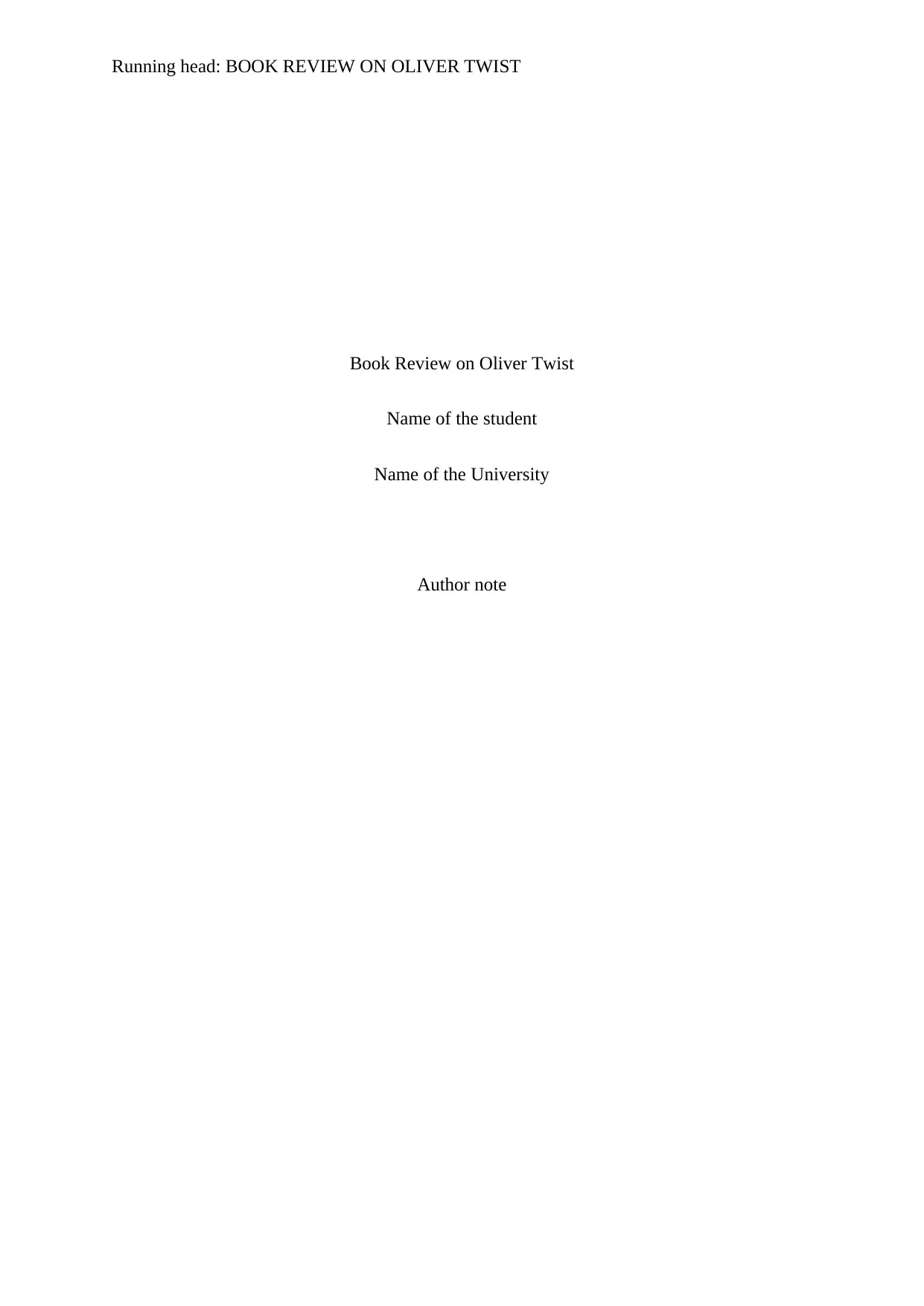
Running head: BOOK REVIEW ON OLIVER TWIST
Book Review on Oliver Twist
Name of the student
Name of the University
Author note
Book Review on Oliver Twist
Name of the student
Name of the University
Author note
Paraphrase This Document
Need a fresh take? Get an instant paraphrase of this document with our AI Paraphraser
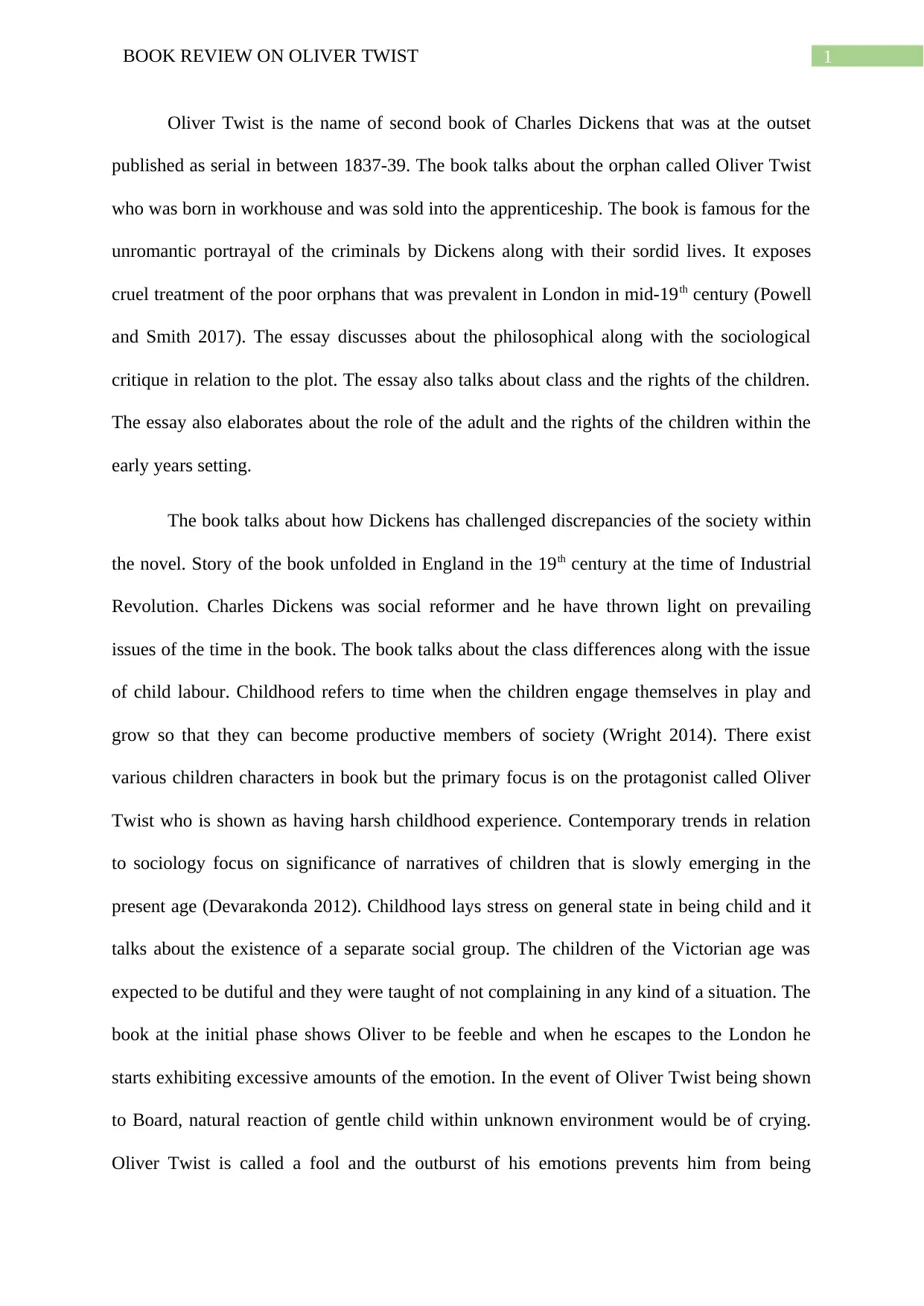
1BOOK REVIEW ON OLIVER TWIST
Oliver Twist is the name of second book of Charles Dickens that was at the outset
published as serial in between 1837-39. The book talks about the orphan called Oliver Twist
who was born in workhouse and was sold into the apprenticeship. The book is famous for the
unromantic portrayal of the criminals by Dickens along with their sordid lives. It exposes
cruel treatment of the poor orphans that was prevalent in London in mid-19th century (Powell
and Smith 2017). The essay discusses about the philosophical along with the sociological
critique in relation to the plot. The essay also talks about class and the rights of the children.
The essay also elaborates about the role of the adult and the rights of the children within the
early years setting.
The book talks about how Dickens has challenged discrepancies of the society within
the novel. Story of the book unfolded in England in the 19th century at the time of Industrial
Revolution. Charles Dickens was social reformer and he have thrown light on prevailing
issues of the time in the book. The book talks about the class differences along with the issue
of child labour. Childhood refers to time when the children engage themselves in play and
grow so that they can become productive members of society (Wright 2014). There exist
various children characters in book but the primary focus is on the protagonist called Oliver
Twist who is shown as having harsh childhood experience. Contemporary trends in relation
to sociology focus on significance of narratives of children that is slowly emerging in the
present age (Devarakonda 2012). Childhood lays stress on general state in being child and it
talks about the existence of a separate social group. The children of the Victorian age was
expected to be dutiful and they were taught of not complaining in any kind of a situation. The
book at the initial phase shows Oliver to be feeble and when he escapes to the London he
starts exhibiting excessive amounts of the emotion. In the event of Oliver Twist being shown
to Board, natural reaction of gentle child within unknown environment would be of crying.
Oliver Twist is called a fool and the outburst of his emotions prevents him from being
Oliver Twist is the name of second book of Charles Dickens that was at the outset
published as serial in between 1837-39. The book talks about the orphan called Oliver Twist
who was born in workhouse and was sold into the apprenticeship. The book is famous for the
unromantic portrayal of the criminals by Dickens along with their sordid lives. It exposes
cruel treatment of the poor orphans that was prevalent in London in mid-19th century (Powell
and Smith 2017). The essay discusses about the philosophical along with the sociological
critique in relation to the plot. The essay also talks about class and the rights of the children.
The essay also elaborates about the role of the adult and the rights of the children within the
early years setting.
The book talks about how Dickens has challenged discrepancies of the society within
the novel. Story of the book unfolded in England in the 19th century at the time of Industrial
Revolution. Charles Dickens was social reformer and he have thrown light on prevailing
issues of the time in the book. The book talks about the class differences along with the issue
of child labour. Childhood refers to time when the children engage themselves in play and
grow so that they can become productive members of society (Wright 2014). There exist
various children characters in book but the primary focus is on the protagonist called Oliver
Twist who is shown as having harsh childhood experience. Contemporary trends in relation
to sociology focus on significance of narratives of children that is slowly emerging in the
present age (Devarakonda 2012). Childhood lays stress on general state in being child and it
talks about the existence of a separate social group. The children of the Victorian age was
expected to be dutiful and they were taught of not complaining in any kind of a situation. The
book at the initial phase shows Oliver to be feeble and when he escapes to the London he
starts exhibiting excessive amounts of the emotion. In the event of Oliver Twist being shown
to Board, natural reaction of gentle child within unknown environment would be of crying.
Oliver Twist is called a fool and the outburst of his emotions prevents him from being
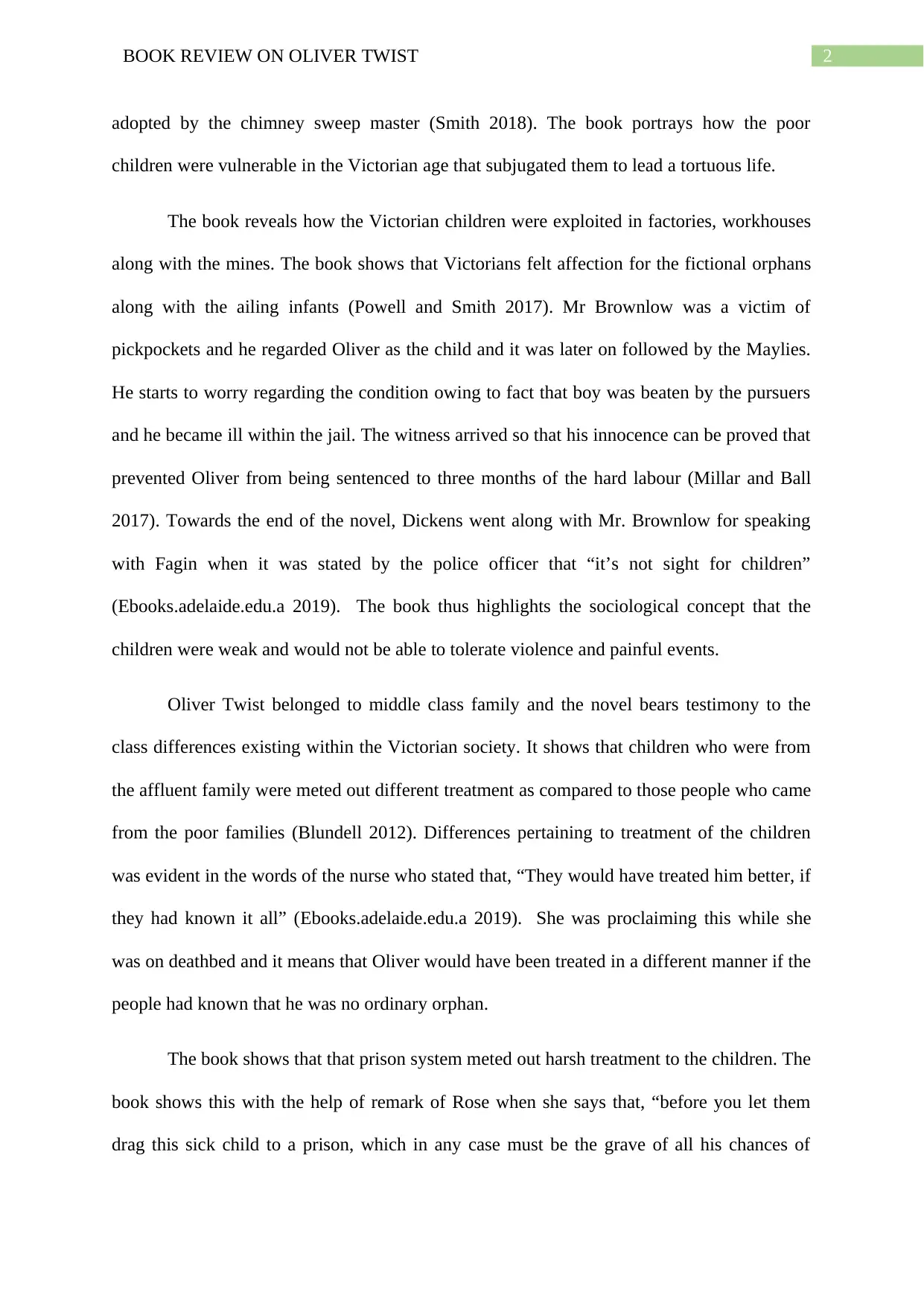
2BOOK REVIEW ON OLIVER TWIST
adopted by the chimney sweep master (Smith 2018). The book portrays how the poor
children were vulnerable in the Victorian age that subjugated them to lead a tortuous life.
The book reveals how the Victorian children were exploited in factories, workhouses
along with the mines. The book shows that Victorians felt affection for the fictional orphans
along with the ailing infants (Powell and Smith 2017). Mr Brownlow was a victim of
pickpockets and he regarded Oliver as the child and it was later on followed by the Maylies.
He starts to worry regarding the condition owing to fact that boy was beaten by the pursuers
and he became ill within the jail. The witness arrived so that his innocence can be proved that
prevented Oliver from being sentenced to three months of the hard labour (Millar and Ball
2017). Towards the end of the novel, Dickens went along with Mr. Brownlow for speaking
with Fagin when it was stated by the police officer that “it’s not sight for children”
(Ebooks.adelaide.edu.a 2019). The book thus highlights the sociological concept that the
children were weak and would not be able to tolerate violence and painful events.
Oliver Twist belonged to middle class family and the novel bears testimony to the
class differences existing within the Victorian society. It shows that children who were from
the affluent family were meted out different treatment as compared to those people who came
from the poor families (Blundell 2012). Differences pertaining to treatment of the children
was evident in the words of the nurse who stated that, “They would have treated him better, if
they had known it all” (Ebooks.adelaide.edu.a 2019). She was proclaiming this while she
was on deathbed and it means that Oliver would have been treated in a different manner if the
people had known that he was no ordinary orphan.
The book shows that that prison system meted out harsh treatment to the children. The
book shows this with the help of remark of Rose when she says that, “before you let them
drag this sick child to a prison, which in any case must be the grave of all his chances of
adopted by the chimney sweep master (Smith 2018). The book portrays how the poor
children were vulnerable in the Victorian age that subjugated them to lead a tortuous life.
The book reveals how the Victorian children were exploited in factories, workhouses
along with the mines. The book shows that Victorians felt affection for the fictional orphans
along with the ailing infants (Powell and Smith 2017). Mr Brownlow was a victim of
pickpockets and he regarded Oliver as the child and it was later on followed by the Maylies.
He starts to worry regarding the condition owing to fact that boy was beaten by the pursuers
and he became ill within the jail. The witness arrived so that his innocence can be proved that
prevented Oliver from being sentenced to three months of the hard labour (Millar and Ball
2017). Towards the end of the novel, Dickens went along with Mr. Brownlow for speaking
with Fagin when it was stated by the police officer that “it’s not sight for children”
(Ebooks.adelaide.edu.a 2019). The book thus highlights the sociological concept that the
children were weak and would not be able to tolerate violence and painful events.
Oliver Twist belonged to middle class family and the novel bears testimony to the
class differences existing within the Victorian society. It shows that children who were from
the affluent family were meted out different treatment as compared to those people who came
from the poor families (Blundell 2012). Differences pertaining to treatment of the children
was evident in the words of the nurse who stated that, “They would have treated him better, if
they had known it all” (Ebooks.adelaide.edu.a 2019). She was proclaiming this while she
was on deathbed and it means that Oliver would have been treated in a different manner if the
people had known that he was no ordinary orphan.
The book shows that that prison system meted out harsh treatment to the children. The
book shows this with the help of remark of Rose when she says that, “before you let them
drag this sick child to a prison, which in any case must be the grave of all his chances of
⊘ This is a preview!⊘
Do you want full access?
Subscribe today to unlock all pages.

Trusted by 1+ million students worldwide
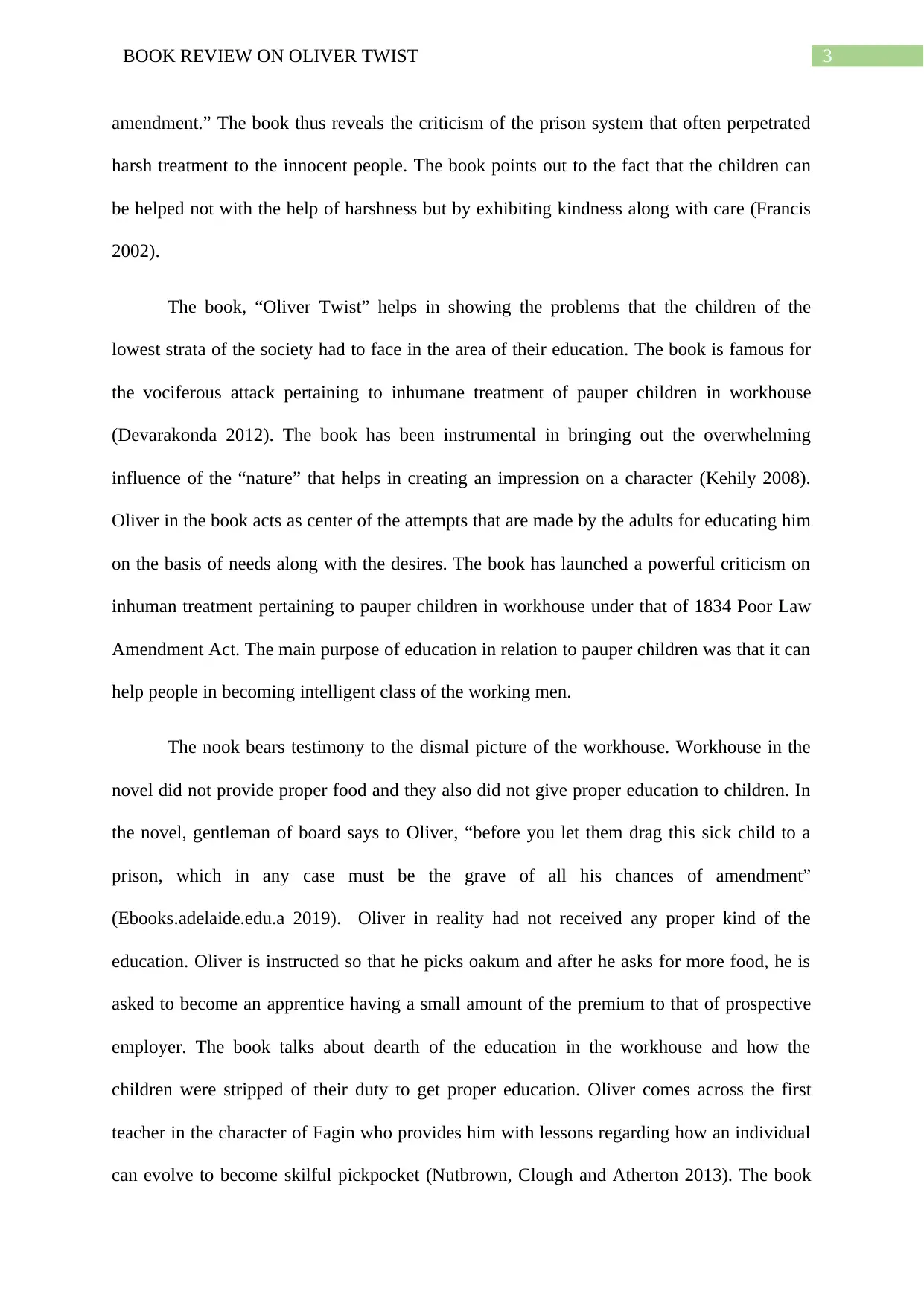
3BOOK REVIEW ON OLIVER TWIST
amendment.” The book thus reveals the criticism of the prison system that often perpetrated
harsh treatment to the innocent people. The book points out to the fact that the children can
be helped not with the help of harshness but by exhibiting kindness along with care (Francis
2002).
The book, “Oliver Twist” helps in showing the problems that the children of the
lowest strata of the society had to face in the area of their education. The book is famous for
the vociferous attack pertaining to inhumane treatment of pauper children in workhouse
(Devarakonda 2012). The book has been instrumental in bringing out the overwhelming
influence of the “nature” that helps in creating an impression on a character (Kehily 2008).
Oliver in the book acts as center of the attempts that are made by the adults for educating him
on the basis of needs along with the desires. The book has launched a powerful criticism on
inhuman treatment pertaining to pauper children in workhouse under that of 1834 Poor Law
Amendment Act. The main purpose of education in relation to pauper children was that it can
help people in becoming intelligent class of the working men.
The nook bears testimony to the dismal picture of the workhouse. Workhouse in the
novel did not provide proper food and they also did not give proper education to children. In
the novel, gentleman of board says to Oliver, “before you let them drag this sick child to a
prison, which in any case must be the grave of all his chances of amendment”
(Ebooks.adelaide.edu.a 2019). Oliver in reality had not received any proper kind of the
education. Oliver is instructed so that he picks oakum and after he asks for more food, he is
asked to become an apprentice having a small amount of the premium to that of prospective
employer. The book talks about dearth of the education in the workhouse and how the
children were stripped of their duty to get proper education. Oliver comes across the first
teacher in the character of Fagin who provides him with lessons regarding how an individual
can evolve to become skilful pickpocket (Nutbrown, Clough and Atherton 2013). The book
amendment.” The book thus reveals the criticism of the prison system that often perpetrated
harsh treatment to the innocent people. The book points out to the fact that the children can
be helped not with the help of harshness but by exhibiting kindness along with care (Francis
2002).
The book, “Oliver Twist” helps in showing the problems that the children of the
lowest strata of the society had to face in the area of their education. The book is famous for
the vociferous attack pertaining to inhumane treatment of pauper children in workhouse
(Devarakonda 2012). The book has been instrumental in bringing out the overwhelming
influence of the “nature” that helps in creating an impression on a character (Kehily 2008).
Oliver in the book acts as center of the attempts that are made by the adults for educating him
on the basis of needs along with the desires. The book has launched a powerful criticism on
inhuman treatment pertaining to pauper children in workhouse under that of 1834 Poor Law
Amendment Act. The main purpose of education in relation to pauper children was that it can
help people in becoming intelligent class of the working men.
The nook bears testimony to the dismal picture of the workhouse. Workhouse in the
novel did not provide proper food and they also did not give proper education to children. In
the novel, gentleman of board says to Oliver, “before you let them drag this sick child to a
prison, which in any case must be the grave of all his chances of amendment”
(Ebooks.adelaide.edu.a 2019). Oliver in reality had not received any proper kind of the
education. Oliver is instructed so that he picks oakum and after he asks for more food, he is
asked to become an apprentice having a small amount of the premium to that of prospective
employer. The book talks about dearth of the education in the workhouse and how the
children were stripped of their duty to get proper education. Oliver comes across the first
teacher in the character of Fagin who provides him with lessons regarding how an individual
can evolve to become skilful pickpocket (Nutbrown, Clough and Atherton 2013). The book
Paraphrase This Document
Need a fresh take? Get an instant paraphrase of this document with our AI Paraphraser
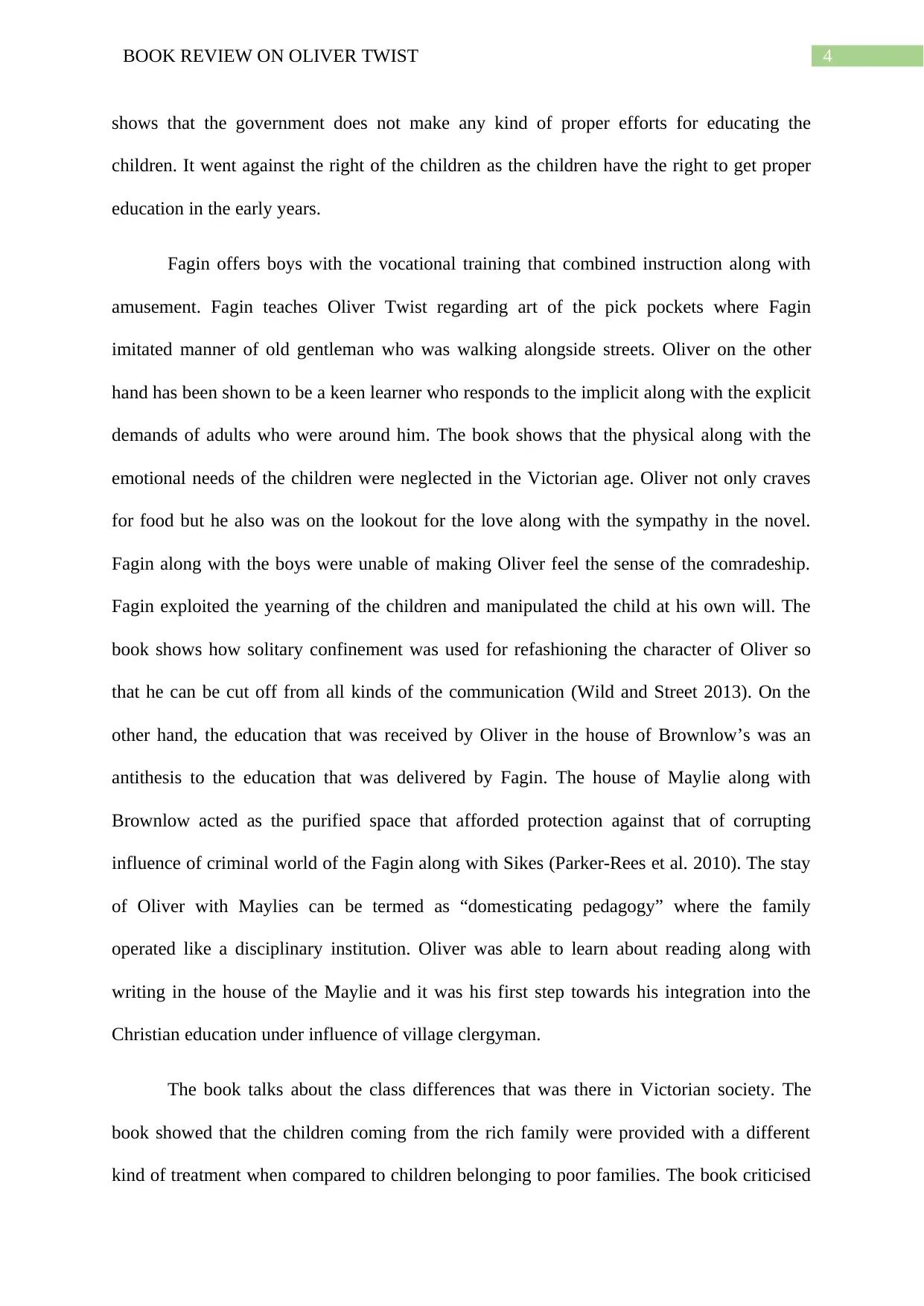
4BOOK REVIEW ON OLIVER TWIST
shows that the government does not make any kind of proper efforts for educating the
children. It went against the right of the children as the children have the right to get proper
education in the early years.
Fagin offers boys with the vocational training that combined instruction along with
amusement. Fagin teaches Oliver Twist regarding art of the pick pockets where Fagin
imitated manner of old gentleman who was walking alongside streets. Oliver on the other
hand has been shown to be a keen learner who responds to the implicit along with the explicit
demands of adults who were around him. The book shows that the physical along with the
emotional needs of the children were neglected in the Victorian age. Oliver not only craves
for food but he also was on the lookout for the love along with the sympathy in the novel.
Fagin along with the boys were unable of making Oliver feel the sense of the comradeship.
Fagin exploited the yearning of the children and manipulated the child at his own will. The
book shows how solitary confinement was used for refashioning the character of Oliver so
that he can be cut off from all kinds of the communication (Wild and Street 2013). On the
other hand, the education that was received by Oliver in the house of Brownlow’s was an
antithesis to the education that was delivered by Fagin. The house of Maylie along with
Brownlow acted as the purified space that afforded protection against that of corrupting
influence of criminal world of the Fagin along with Sikes (Parker-Rees et al. 2010). The stay
of Oliver with Maylies can be termed as “domesticating pedagogy” where the family
operated like a disciplinary institution. Oliver was able to learn about reading along with
writing in the house of the Maylie and it was his first step towards his integration into the
Christian education under influence of village clergyman.
The book talks about the class differences that was there in Victorian society. The
book showed that the children coming from the rich family were provided with a different
kind of treatment when compared to children belonging to poor families. The book criticised
shows that the government does not make any kind of proper efforts for educating the
children. It went against the right of the children as the children have the right to get proper
education in the early years.
Fagin offers boys with the vocational training that combined instruction along with
amusement. Fagin teaches Oliver Twist regarding art of the pick pockets where Fagin
imitated manner of old gentleman who was walking alongside streets. Oliver on the other
hand has been shown to be a keen learner who responds to the implicit along with the explicit
demands of adults who were around him. The book shows that the physical along with the
emotional needs of the children were neglected in the Victorian age. Oliver not only craves
for food but he also was on the lookout for the love along with the sympathy in the novel.
Fagin along with the boys were unable of making Oliver feel the sense of the comradeship.
Fagin exploited the yearning of the children and manipulated the child at his own will. The
book shows how solitary confinement was used for refashioning the character of Oliver so
that he can be cut off from all kinds of the communication (Wild and Street 2013). On the
other hand, the education that was received by Oliver in the house of Brownlow’s was an
antithesis to the education that was delivered by Fagin. The house of Maylie along with
Brownlow acted as the purified space that afforded protection against that of corrupting
influence of criminal world of the Fagin along with Sikes (Parker-Rees et al. 2010). The stay
of Oliver with Maylies can be termed as “domesticating pedagogy” where the family
operated like a disciplinary institution. Oliver was able to learn about reading along with
writing in the house of the Maylie and it was his first step towards his integration into the
Christian education under influence of village clergyman.
The book talks about the class differences that was there in Victorian society. The
book showed that the children coming from the rich family were provided with a different
kind of treatment when compared to children belonging to poor families. The book criticised
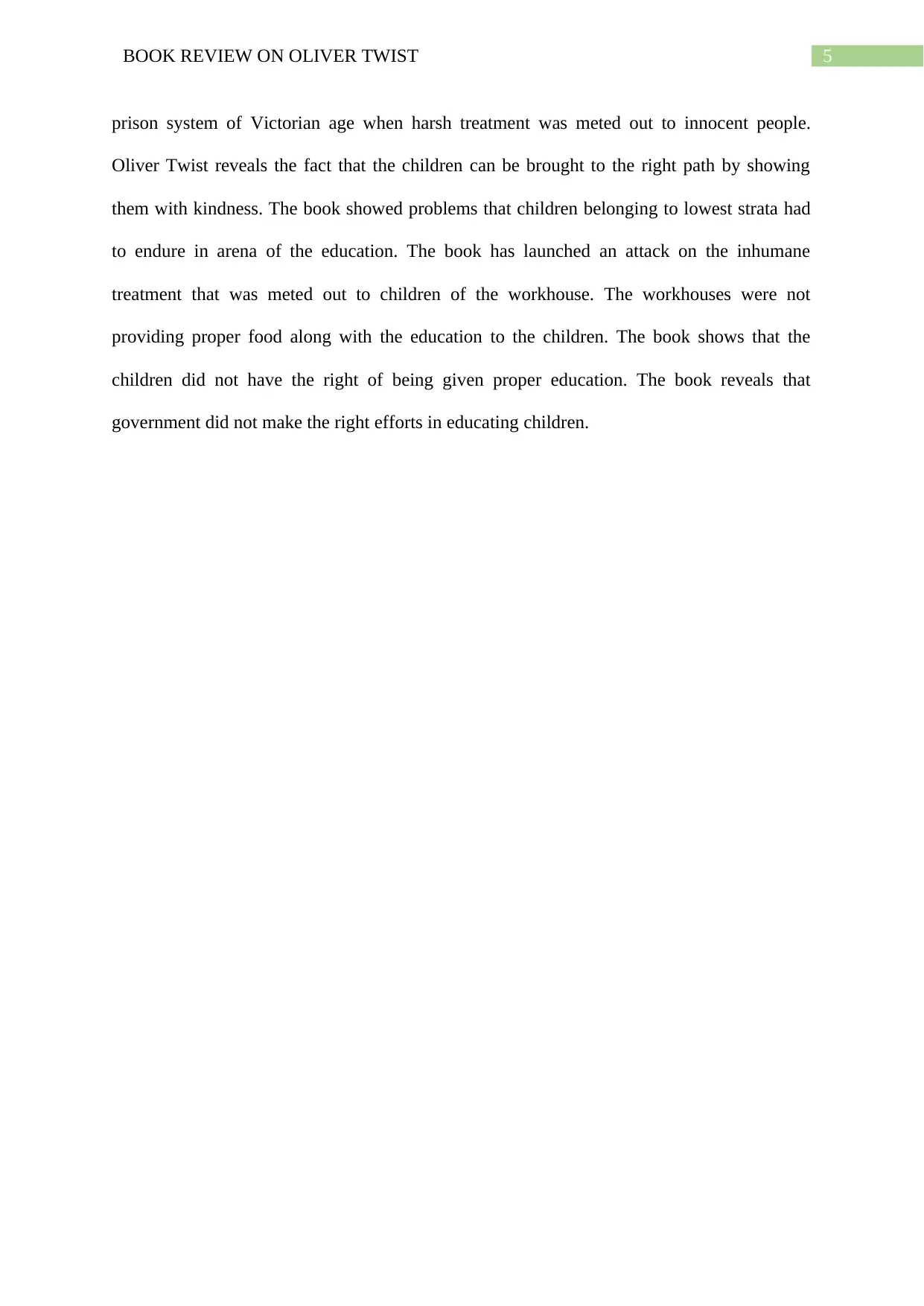
5BOOK REVIEW ON OLIVER TWIST
prison system of Victorian age when harsh treatment was meted out to innocent people.
Oliver Twist reveals the fact that the children can be brought to the right path by showing
them with kindness. The book showed problems that children belonging to lowest strata had
to endure in arena of the education. The book has launched an attack on the inhumane
treatment that was meted out to children of the workhouse. The workhouses were not
providing proper food along with the education to the children. The book shows that the
children did not have the right of being given proper education. The book reveals that
government did not make the right efforts in educating children.
prison system of Victorian age when harsh treatment was meted out to innocent people.
Oliver Twist reveals the fact that the children can be brought to the right path by showing
them with kindness. The book showed problems that children belonging to lowest strata had
to endure in arena of the education. The book has launched an attack on the inhumane
treatment that was meted out to children of the workhouse. The workhouses were not
providing proper food along with the education to the children. The book shows that the
children did not have the right of being given proper education. The book reveals that
government did not make the right efforts in educating children.
⊘ This is a preview!⊘
Do you want full access?
Subscribe today to unlock all pages.

Trusted by 1+ million students worldwide
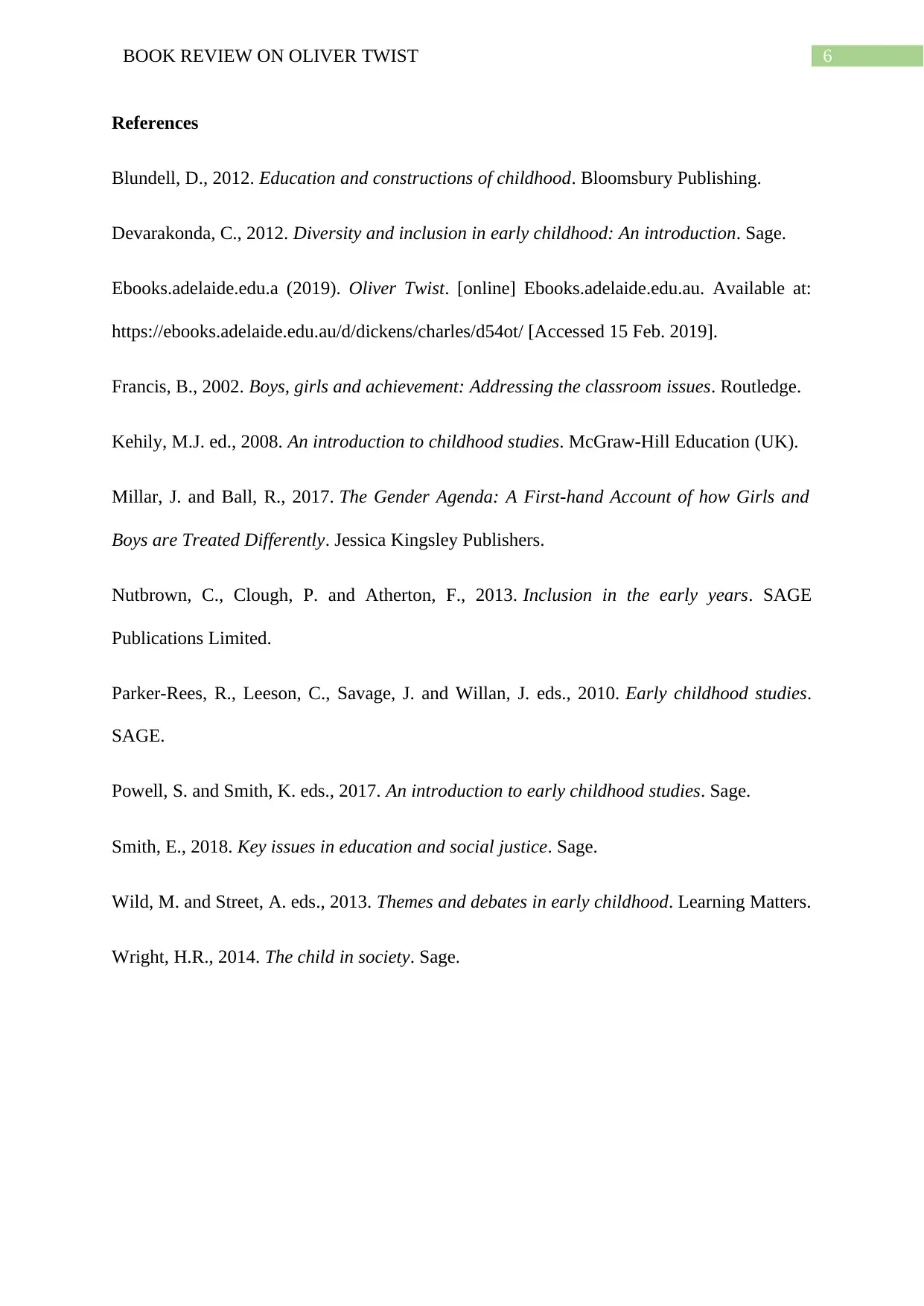
6BOOK REVIEW ON OLIVER TWIST
References
Blundell, D., 2012. Education and constructions of childhood. Bloomsbury Publishing.
Devarakonda, C., 2012. Diversity and inclusion in early childhood: An introduction. Sage.
Ebooks.adelaide.edu.a (2019). Oliver Twist. [online] Ebooks.adelaide.edu.au. Available at:
https://ebooks.adelaide.edu.au/d/dickens/charles/d54ot/ [Accessed 15 Feb. 2019].
Francis, B., 2002. Boys, girls and achievement: Addressing the classroom issues. Routledge.
Kehily, M.J. ed., 2008. An introduction to childhood studies. McGraw-Hill Education (UK).
Millar, J. and Ball, R., 2017. The Gender Agenda: A First-hand Account of how Girls and
Boys are Treated Differently. Jessica Kingsley Publishers.
Nutbrown, C., Clough, P. and Atherton, F., 2013. Inclusion in the early years. SAGE
Publications Limited.
Parker-Rees, R., Leeson, C., Savage, J. and Willan, J. eds., 2010. Early childhood studies.
SAGE.
Powell, S. and Smith, K. eds., 2017. An introduction to early childhood studies. Sage.
Smith, E., 2018. Key issues in education and social justice. Sage.
Wild, M. and Street, A. eds., 2013. Themes and debates in early childhood. Learning Matters.
Wright, H.R., 2014. The child in society. Sage.
References
Blundell, D., 2012. Education and constructions of childhood. Bloomsbury Publishing.
Devarakonda, C., 2012. Diversity and inclusion in early childhood: An introduction. Sage.
Ebooks.adelaide.edu.a (2019). Oliver Twist. [online] Ebooks.adelaide.edu.au. Available at:
https://ebooks.adelaide.edu.au/d/dickens/charles/d54ot/ [Accessed 15 Feb. 2019].
Francis, B., 2002. Boys, girls and achievement: Addressing the classroom issues. Routledge.
Kehily, M.J. ed., 2008. An introduction to childhood studies. McGraw-Hill Education (UK).
Millar, J. and Ball, R., 2017. The Gender Agenda: A First-hand Account of how Girls and
Boys are Treated Differently. Jessica Kingsley Publishers.
Nutbrown, C., Clough, P. and Atherton, F., 2013. Inclusion in the early years. SAGE
Publications Limited.
Parker-Rees, R., Leeson, C., Savage, J. and Willan, J. eds., 2010. Early childhood studies.
SAGE.
Powell, S. and Smith, K. eds., 2017. An introduction to early childhood studies. Sage.
Smith, E., 2018. Key issues in education and social justice. Sage.
Wild, M. and Street, A. eds., 2013. Themes and debates in early childhood. Learning Matters.
Wright, H.R., 2014. The child in society. Sage.
1 out of 7
Your All-in-One AI-Powered Toolkit for Academic Success.
+13062052269
info@desklib.com
Available 24*7 on WhatsApp / Email
![[object Object]](/_next/static/media/star-bottom.7253800d.svg)
Unlock your academic potential
Copyright © 2020–2025 A2Z Services. All Rights Reserved. Developed and managed by ZUCOL.

